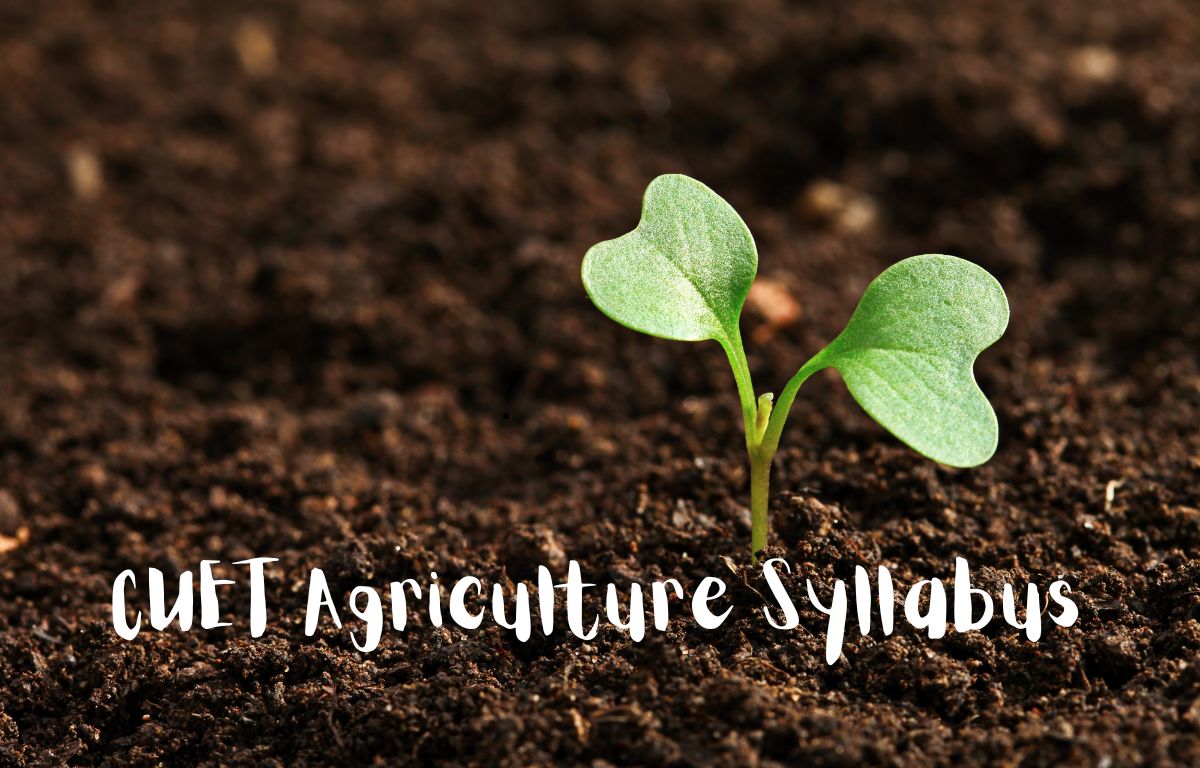Table of Contents
The CUET UG Agriculture Exam for the 2025-26 academic year will be organized by the National Testing Agency (NTA). Students interested in appearing for this exam can now access and download the syllabus for Agriculture from the official website: https://exams.nta.ac.in/CUET-UG/. It’s important for candidates to review the updated syllabus, which includes all the key topics for the exam. To prepare effectively, students should also review previous years’ CUET UG Agriculture question papers. These papers will help them understand the exam pattern and frequently asked questions. Make sure to check the syllabus and practice past papers before the exam.
CUET UG 2025
The CUET UG Agriculture exam is a test for students who want to study agriculture in college. It covers subjects like biology, general knowledge, and chemistry related to farming and crops. The exam checks how well students understand these topics. Preparing for the exam means studying important concepts and practicing questions. Doing well in this examination can help students get into good colleges to pursue their dream of learning about agriculture.
The exam includes multiple-choice questions on topics like agriculture, biology, chemistry, and physics. The test checks students’ knowledge of farming, plants, and animals. After passing this exam, students can study courses like B.Sc. Agriculture, B.Sc. Horticulture, B.Sc. Forestry, and B.Sc. Animal Husbandry in various colleges across India.
CUET UG Agriculture Syllabus 2025
The CUET UG Agriculture syllabus teaches students about farming and growing crops. It covers topics like plants, soil, animals, and managing farms. Students learn how to grow different crops, take care of the soil, and manage farm work. The CUET syllabus also includes basic knowledge of biotechnology, pest control, and protecting the environment while farming.
This helps students understand how to grow more food and make farming better for the planet. With this knowledge, they can work on farms, in research, or in agriculture-related jobs. The syllabus is made to prepare students for a career in agriculture and help create a healthier environment and food supply.
CUET UG Agriculture: Exam Pattern
The CUET 2025 is a multiple-choice exam where you select the correct answer from options. It includes subjects like Physics, Chemistry, Biology, and sometimes Mathematics and Agriculture. You get points for correct answers, but there’s a negative marking for wrong answers. This test helps colleges decide who can join their agriculture programs. To do well, focus on studying these subjects and understanding the important concepts. Good preparation will improve your chances of performing well and getting into the program you want.
| CUET UG Agriculture Syllabus 2025 | |
| Conducting Body | National Testing Agency [NTA] |
| Name of Examination | CUET UG Agriculture Examination 2025 |
| Full Form | Common University Entrance Test Undergraduate Agriculture Examination 2025 |
| Language of Examination | 13 languages – English, Hindi, Assamese, Bengali, Gujarati, Kannada, Malayalam, Marathi, Odia, Punjabi, Tamil, Telugu, and Urdu |
| Type of Question | Multiple Choice Questions (MCQs) |
| Total no. of Questions | 50 questions |
| Duration of exam | 45 minutes |
| Marking Scheme |
|
| CUET Agriculture Mapping for Courses |
|
CUET Agriculture Unit Wise Syllabus 2025
The CUET UG Agriculture syllabus is divided into different units. These units cover topics like crop production, soil science, horticulture, and animal husbandry. Each unit focuses on specific areas, such as how plants grow, the types of soil and their importance, different fruits and vegetables, and how to care for farm animals.
The CUET Agriculture Syllabus 2025 focuses on basic knowledge of agriculture tools, techniques, and sustainable farming methods. It is designed to help students easily understand important topics related to farming and agriculture. The goal is to provide a well-rounded understanding of these subjects so students can grasp them more effectively and with less difficulty. By covering the key areas, the syllabus aims to make learning about agriculture simpler and more accessible for all students.
Unit 1: Agrometeorology, Genetics and Plant Breeding, Biochemistry and Microbiology
Agrometeorology: Elements of Weather-rainfall, temperature, humidity, wind velocity, Sunshine, weather forecasting, climate change in relation to crop production.
Genetics & Plant Breeding:
- Cell and its structure, cell division- mitosis and meiosis, and their significance
- Organization of the genetic materials in chromosomes, DNA, and RNA
- Mendel’s laws of inheritance. Reasons for the success of Mendel in his experiments. Absence of linkage in Mendel’s experiments.
- Quantitative inheritance, continuous and discontinuous variation in plants.
- Monogenic and polygenic inheritance.
- Role of Genetics in Plant breeding, self and cross-pollinated crops, methods of breeding in field crops-introduction, selection, hybridization, mutation and polyploidy, tissue and cell culture.
- Plant Biotechnology definition and scope in crop production
Biochemistry: pH and buffers, Classification and nomenclature of carbohydrates; proteins; lipids; vitamins, and enzymes.
Microbiology: Microbial cell structure, Micro-organisms- Algae, Bacteria, Fungi, Actinomycetes,
Protozoa and Viruses. Role of micro-organisms in respiration, fermentation, and organic matter
decomposition.
Unit 2: Livestock Production
Scope and Importance:
- Importance of livestock in agriculture and industry, White revolution in India.
- Important breeds, Indian and exotic, distribution of cows, buffaloes, and poultry in India.
Care and Management:
- Systems of cattle and poultry housing
- Principles of feeding, and feeding practices.Balanced ration definition and ingredients.
- Management of calves, bullocks, pregnant and milch animals as well as chicks, cockerels and layers, and poultry.
- Signs of sick animals, symptoms of common diseases in cattle and poultry, Rinderpest, black quarter, foot and mouth, mastitis, and hemorrhagic septicemia, coccidiosis, Fowl pox, and Ranikhet disease, their prevention, and control.
Artificial Insemination: Reproductive organs, collection, dilution, and preservation of semen, and artificial insemination, role of artificial insemination in cattle improvement. Livestock Products: Processing and marketing of milk and Milk products.
Unit 3: Crop Production
Introduction:
- Targets and achievements in food grain production in India since independence and its future projections, sustainable crop production, commercialization of agriculture, and its scope in India.
- Classification of field crops based on their utility: cereals, pulses, oilseeds, fiber, sugar, and forage crops.
Soil, Soil fertility, Fertilizers, and Manures:
- Soil, soil pH, Soil texture, soil structure, soil organisms, soil tilth, soil fertility, and soil health.
- Essential plant nutrients, their functions, and deficiency symptoms.
- Soil types of India and their characteristics.
- Organic manure, common fertilizers including straight, complex, fertilizer mixtures and biofertilizers; integrated nutrient management system.
Irrigation and Drainage:
- Sources of irrigation (rain, canals, tanks, rivers, wells, tubewells).
- Scheduling of irrigation based on critical stages of growth, time interval, soil moisture content, and weather parameters.
- Water requirement of crops.
- Methods of irrigation and drainage.
- Watershed management
Weed Control: Principles of weed control, methods of weed control (cultural, mechanical, chemical, biological, and Integrated weed management).
Crops: Seedbed preparation, seed treatment, time and method of sowing/planting, seed rate; dose, method, and time of fertilizer application, irrigation, intercultural and weed control; common pests and diseases, caused by bacteria, fungi viruses, and nematode and their control, integrated pest management, harvesting, threshing, postharvest technology: storage, processing, and marketing of major field crops-Rice, wheat, maize, sorghum, pearl millet, groundnut, mustard, pigeon-pea, gram, sugarcane, cotton, and berseem.
Unit 4: Horticulture
- Importance of fruits and vegetables in the human diet, Crop diversification & processing Industry.
- Orchard- location and layout, ornamental gardening, and kitchen garden.
- Planting system, training, pruning, intercropping, protection from frost and sunburn.
- Trees, shrubs, climbers, annuals, perennials-definition and examples. Propagation by seed, cutting, budding, layering, and grafting.
- Cultivation practices, processing, and marketing of (i) Fruits – mango, papaya, banana, guava, citrus, grapes. (ii) Vegetables – Radish, carrot, potato, onion, cauliflower, brinjal, tomato, spinach, and cabbage. (iii) Flowers – Gladiolus, canna, chrysanthemums, roses and marigold.
- Principles and methods of fruit and vegetable preservation.
- Preparation of jellies, jams, ketchup, chips, and their packing
Best Books For CUET UG Agriculture Preparation
Choosing the right books is very important for students getting ready for the CUET UG Agriculture exam. Good books can help you understand the basics better and give you a stronger chance of doing well on the test. Make sure to pick books that explain things clearly and cover the topics that are part of the exam. This way, you’ll build a solid foundation and be better prepared for the challenges of the CUET UG Agriculture exam. Here are some of the best books to help you succeed:
- Arihant’s CUET UG Agriculture – This book covers all the essential topics in a clear and concise manner.
- NCERT Biology Books – The NCERT Biology textbooks for Class 11 and 12 are crucial for understanding basic concepts.
- Principles of Agronomy by Reddy & Reddy – This book provides in-depth knowledge of agronomy.
- Soil Science by T.D. Biswas – It offers a solid foundation in soil science.
- Objective Agriculture by S.R. Kantwa – A good resource for practicing objective questions.
- Fundamentals of Agriculture by Arun Katyayan – Covers various agricultural topics comprehensively.
CUET Agriculture Previous Year Question Paper
The National Testing Agency, which conducts the CUET Exam every year, has now activated the official window to check and download the previous year’s question papers of the CUET Agriculture exam so that all the students can now complete their preparations using them. To help students access the CUET Agriculture Previous Year Question Paper, we have added a direct link ahead. This link will connect to a new window where all the students will get to access year-wise CUET Agriculture Previous Year Question Papers.


 CUET Eligibility Criteria 2025: Age Limi...
CUET Eligibility Criteria 2025: Age Limi...
 CUET UG 2025: Most Important 50 Question...
CUET UG 2025: Most Important 50 Question...
 CUET 2025 Exam Day Instructions and Guid...
CUET 2025 Exam Day Instructions and Guid...



